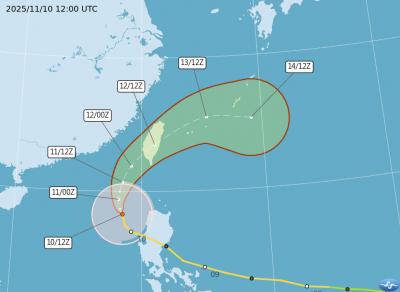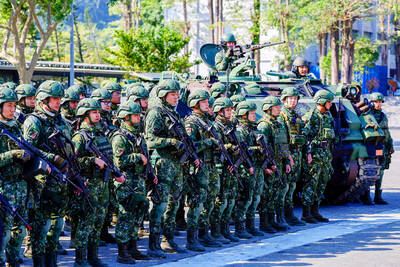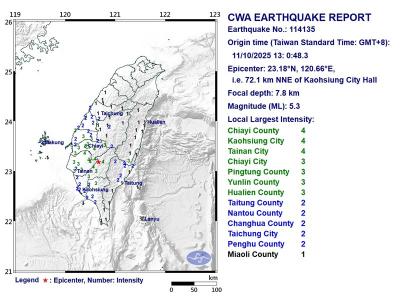There are many stories to explain why the people of Taitung County celebrate the annual Lantern Festival by throwing firecrackers at a shirtless man playing the role of the diety Han Dan (寒單爺), but what is certain is that the ritual has evolved into a treasured cultural event.
The county government registered the ritual of “bombing Han Dan” — held to coincide with the Lantern Festival — as a cultural asset last year after it was recognized as a folk ritual that contributes significantly to tourism.
Taitung’s firecracker blitzkrieg has become one of the most representative traditional ceremonies marking the end of the Lunar New Year season in Taiwan along with the sky lanterns in Taipei County’s Pingsi Township (平溪) and the firecracker beehive festival in Tainan County’s Yenshui Township (鹽水).
Taitung locals have offered themselves up as targets for firecrackers since the Japanese colonial era, but how the ritual gained traction is the stuff of legend.
One version is that the ritual grew popular because people believed it helped rid Taitung of infectious diseases plaguing the area during that time.
Legend has it that an epidemic was brought under control after Han Dan was brought out during the Lantern Festival to expel evil spirits while offering blessings to believers, thus leading to the yearly ritual of worshiping the deity.
Scientists believe that the heat and thick smoke filling the sky from the bombardment of firecrackers may have actually stemmed the spread of dangerous bacteria.
But who is Han Dan?
Some cultural historians said Han Dan was a god of wealth who could not resist the cold.
Throwing firecrackers at him was meant to drive the chill from his body during the procession. The more firecrackers that were set off, the more successful and wealthy devotees would become.
During the ceremony, a chosen person (normally a male) dresses up as Han Dan, stands on a sedan chair in a parade and presents himself to devotees who throw firecrackers at him.
The man can only use a banyan branch to protect himself.
Another version of story is that Han Dan was the god of gangsters and hooligans, who used firecrackers to demonstrate his power.
In the 1970s and 1980s, the Han Dan role was often assumed by a local organized crime boss.
Some alleged that the “bombing of Han Dan” actually turned into a contest among leaders of rival factions to decide who would become the big boss.
It was said that whoever endured the bombardment the longest took over as gang leader.
That practice, however, led to Taitung police banning the ritual in 1984, and leaders of local gangs were then sent to jail during raids on organized crime syndicates.
In 1989, former legislator Yao Eng-chi (饒穎奇) of the Chinese Nationalist Party (KMT) revived the tradition.
Since then, the ceremony has been transformed from a power struggle among gangsters into an economic indicator.

The Central Weather Administration (CWA) today issued a sea warning for Typhoon Fung-wong effective from 5:30pm, while local governments canceled school and work for tomorrow. A land warning is expected to be issued tomorrow morning before it is expected to make landfall on Wednesday, the agency said. Taoyuan, and well as Yilan, Hualien and Penghu counties canceled work and school for tomorrow, as well as mountainous district of Taipei and New Taipei City. For updated information on closures, please visit the Directorate-General of Personnel Administration Web site. As of 5pm today, Fung-wong was about 490km south-southwest of Oluanpi (鵝鑾鼻), Taiwan's southernmost point.

Almost a quarter of volunteer soldiers who signed up from 2021 to last year have sought early discharge, the Legislative Yuan’s Budget Center said in a report. The report said that 12,884 of 52,674 people who volunteered in the period had sought an early exit from the military, returning NT$895.96 million (US$28.86 million) to the government. In 2021, there was a 105.34 percent rise in the volunteer recruitment rate, but the number has steadily declined since then, missing recruitment targets, the Chinese-language United Daily News said, citing the report. In 2021, only 521 volunteers dropped out of the military, the report said, citing

A magnitude 5.3 earthquake struck Kaohsiung at 1pm today, the Central Weather Administration said. The epicenter was in Jiasian District (甲仙), 72.1km north-northeast of Kaohsiung City Hall, at a depth of 7.8km, agency data showed. There were no immediate reports of damage. The earthquake's intensity, which gauges the actual effects of a temblor, was highest in Kaohsiung and Tainan, where it measured a 4 on Taiwan's seven-tier intensity scale. It also measured a 3 in parts of Chiayi City, as well as Pingtung, Yunlin and Hualien counties, data showed.

Nearly 5 million people have signed up to receive the government’s NT$10,000 (US$322) universal cash handout since registration opened on Wednesday last week, with deposits expected to begin tomorrow, the Ministry of Finance said yesterday. After a staggered sign-up last week — based on the final digit of the applicant’s national ID or Alien Resident Certificate number — online registration is open to all eligible Taiwanese nationals, foreign permanent residents and spouses of Taiwanese nationals. Banks are expected to start issuing deposits from 6pm today, the ministry said. Those who completed registration by yesterday are expected to receive their NT$10,000 tomorrow, National Treasury